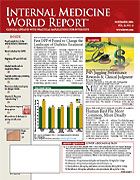Publication
Article
Internal Medicine World Report
Drug-Resistance HIV: The Changing Face of an Epidemic
Drug-Resistance HIV: The Changing Face of an Epidemic
Poor Compliance a Major Culprit
By Amy Selwyn
NEW YORK—As if HIV infection is not bad enough, the reports of growing drug resistance are sounding a new alarm. Patients infected with HIV who are taking most but not all their antiretroviral drugs are likely to develop resistance to their treatment. The use of 3-drug combination that constitutes the highly active antiretroviral therapy(HAART) regimen has dramatically reduced HIV/AIDS mortality in the past 10 years, but this success is now being accompanied by the development of new, drug-resistant strains of HIV.
Data from a major study recently presented at an American Medical Association briefing, “HIV/AIDS: The Drug Resistance Epidemic,” show that 80% adherence to HAART quadruples the risk of developing resistance to one or more drugs.
More than 1100 HIV-infected patients from British Columbia who began treatment with a HAART regimen between 1996 and 1999 were followed for up to 2.5 years. Therapy consisted of 2 nucleoside reverse transcriptase inhibitors and either a protease inhibitor or nonnucleoside reverse transcriptase inhibitor. Prescription refill records were used to estimate patient compliance.
During the follow-up period, 25% of the patients showed evidence of HIV drug resistance. Most important predictors were levels of CD4 cell count at onset of therapy and patient adherence to therapy.
Patients with a nearly perfect record of refilling their HAART prescriptions (>95% refill rate) who took their prescriptions as directed had a 4-fold smaller risk of developing resistance compared with inconsistent users. “The worst place to be was taking 70%, 80%, even 90% of the medications,” said P. Richard Harrigan, PhD, director, British Columbia Centre for Excellence in HIV/AIDS, Vancouver, Canada, who presented the findings.
“Nonadherence is unforgiving with HIV infection,” said John G. Bartlett, MD, chief, Division of Infectious Diseases, Johns Hopkins School of Medicine, Baltimore, Md. “If you don’t take your blood pressure medication tomorrow, your blood pressure will go up. But take it the next day and blood pressure will go down again. With HIV, if you miss your pills, you don’t get the advantage to have them more active or effective later.”
One of the main strategies to fight HIV/AIDS these days is to develop drugs that are active against novel HIV targets. Daniel Kuritzkes, MD, of Harvard Medical School, Boston, discussed the first fusion inhibitor, a new drug class, recently approved for HIV infection—enfuvirtide(Fuzeon). Dr Kuritzkes participated in the randomized clinical trial, theT-20 (Fuzeon) versus Optimized Regimen Only (TORO). Enrollment was restricted to patients whose antiretroviral therapy had frequently failed or who had virus resistant to several drug classes, or both.
New techniques to identify drug resistance include genotypic-resistance testing, which detects the presence of specific genetic mutations thought to cause drug resistance, and phenotypic-resistance testing, which directly measures the ability of a virus to grow in the presence of known concentrations of antiretroviral drugs. (Phenotypic testing is not yet widely available.) “We have good evidence from both retrospective and prospective studies that genotypic testing is cost-effective,” Dr Kuritskes noted.
One of the reasons for HIV drug resistance has been that treatment regimens require use of multiple tablets taken at different times and with different food restrictions. Currently, 3-drug regimen is the rule. “In the 1995 to 1996 era, we had people taking 20 pills. It looks like next year we are going to be down to perhaps 1 pill once a day,” said Dr Bartlett.
In the meantime, a team effort is required to help patients infected with HIV deal with problems of adherence and drug resistance.
